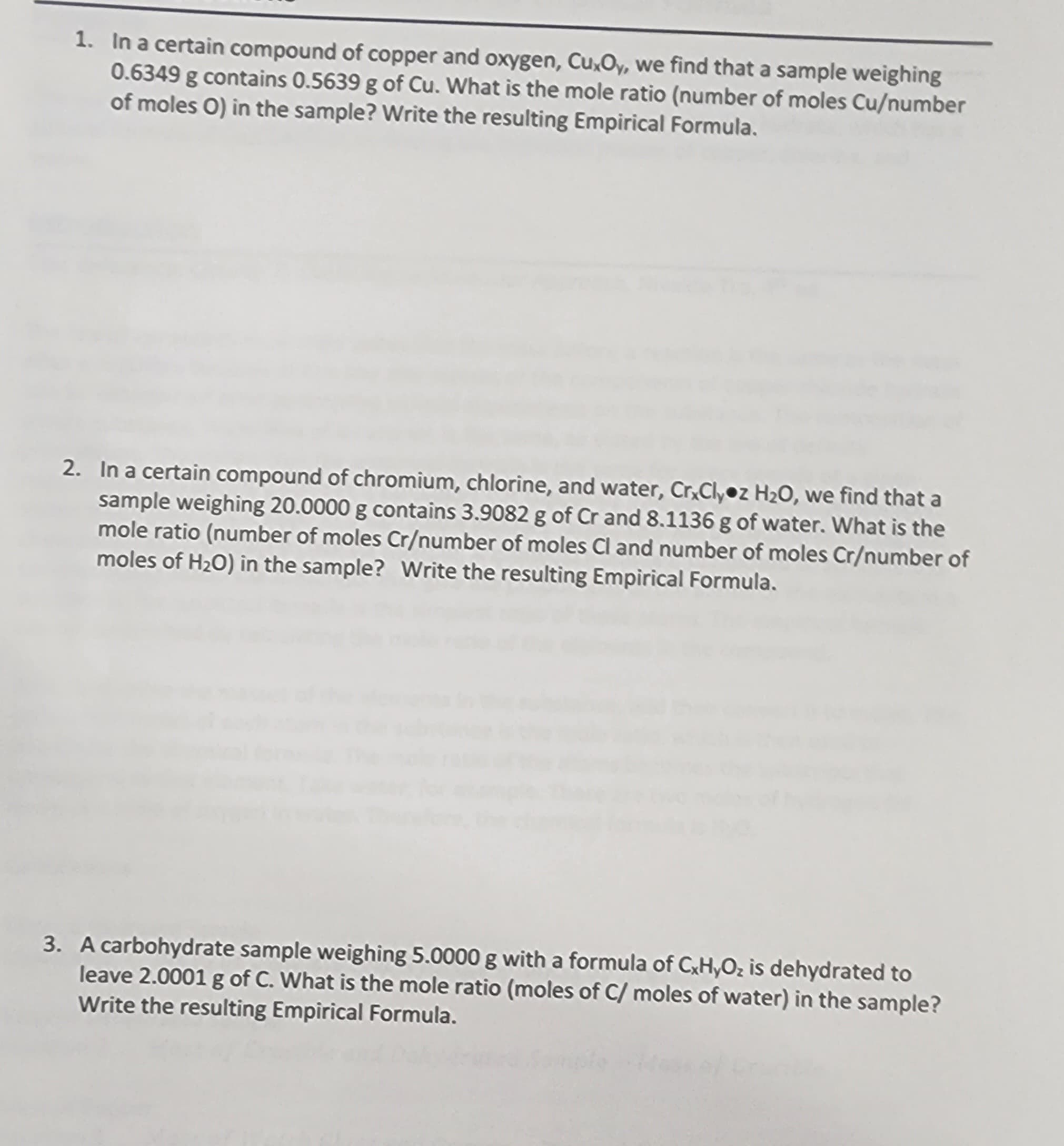1. In a certain compound of copper and oxygen, CuxOy, we find that a sample weighing 0.6349 g contains 0.5639 g of Cu. What is the mole ratio (number of moles Cu/number of moles O) in the sample? Write the resulting Empirical Formula.
1. In a certain compound of copper and oxygen, CuxOy, we find that a sample weighing 0.6349 g contains 0.5639 g of Cu. What is the mole ratio (number of moles Cu/number of moles O) in the sample? Write the resulting Empirical Formula.
Chemical Principles in the Laboratory
11th Edition
ISBN:9781305264434
Author:Emil Slowinski, Wayne C. Wolsey, Robert Rossi
Publisher:Emil Slowinski, Wayne C. Wolsey, Robert Rossi
Chapter33: Preparation Of Copper(i) Chloride
Section: Chapter Questions
Problem 5ASA
Related questions
Question
100%

Transcribed Image Text:1. In a certain compound of copper and oxygen, CuxOy, we find that a sample weighing
0.6349 g contains 0.5639 g of Cu. What is the mole ratio (number of moles Cu/number
of moles O) in the sample? Write the resulting Empirical Formula.
2. In a certain compound of chromium, chlorine, and water, CrxClyoz H₂O, we find that a
sample weighing 20.0000 g contains 3.9082 g of Cr and 8.1136 g of water. What is the
mole ratio (number of moles Cr/number of moles Cl and number of moles Cr/number of
moles of H₂O) in the sample? Write the resulting Empirical Formula.
3. A carbohydrate sample weighing 5.0000 g with a formula of CxHyO₂ is dehydrated to
leave 2.0001 g of C. What is the mole ratio (moles of C/ moles of water) in the sample?
Write the resulting Empirical Formula.
Expert Solution
This question has been solved!
Explore an expertly crafted, step-by-step solution for a thorough understanding of key concepts.
This is a popular solution!
Trending now
This is a popular solution!
Step by step
Solved in 3 steps

Knowledge Booster
Learn more about
Need a deep-dive on the concept behind this application? Look no further. Learn more about this topic, chemistry and related others by exploring similar questions and additional content below.Recommended textbooks for you

Chemical Principles in the Laboratory
Chemistry
ISBN:
9781305264434
Author:
Emil Slowinski, Wayne C. Wolsey, Robert Rossi
Publisher:
Brooks Cole

Chemistry: Principles and Reactions
Chemistry
ISBN:
9781305079373
Author:
William L. Masterton, Cecile N. Hurley
Publisher:
Cengage Learning

Introductory Chemistry: A Foundation
Chemistry
ISBN:
9781337399425
Author:
Steven S. Zumdahl, Donald J. DeCoste
Publisher:
Cengage Learning

Chemical Principles in the Laboratory
Chemistry
ISBN:
9781305264434
Author:
Emil Slowinski, Wayne C. Wolsey, Robert Rossi
Publisher:
Brooks Cole

Chemistry: Principles and Reactions
Chemistry
ISBN:
9781305079373
Author:
William L. Masterton, Cecile N. Hurley
Publisher:
Cengage Learning

Introductory Chemistry: A Foundation
Chemistry
ISBN:
9781337399425
Author:
Steven S. Zumdahl, Donald J. DeCoste
Publisher:
Cengage Learning

Chemistry: The Molecular Science
Chemistry
ISBN:
9781285199047
Author:
John W. Moore, Conrad L. Stanitski
Publisher:
Cengage Learning

Chemistry & Chemical Reactivity
Chemistry
ISBN:
9781133949640
Author:
John C. Kotz, Paul M. Treichel, John Townsend, David Treichel
Publisher:
Cengage Learning

Chemistry & Chemical Reactivity
Chemistry
ISBN:
9781337399074
Author:
John C. Kotz, Paul M. Treichel, John Townsend, David Treichel
Publisher:
Cengage Learning